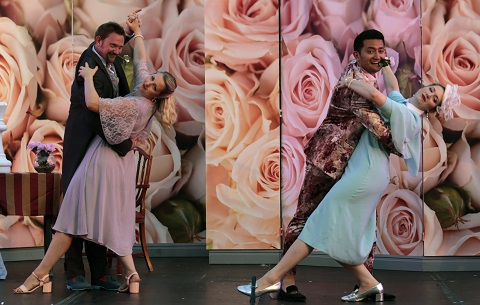American author Gail Carson Levine’s award-winning fantasy-novelElla Enchanted was published in 1997, and as recently as 2015 Walt Disney Pictures revisited the romantic fantasy, producing a
live-action re-imagining of the original 1950 animated film. Both a
Filipino pop group that rose to prominence in the 1970s, and an American
glam rock band formed in Pennsylvania in 1982 and which had a series of
multi-platinum albums and hit singles, chose to call themselves after the
undervalued skivvy.
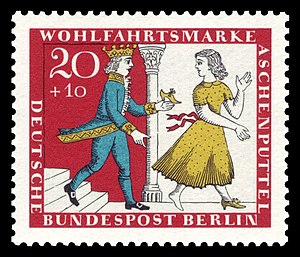 Postage stamp issued in West Berlin in 1965 which depicts Cinderella leaving behind her golden slipper
Postage stamp issued in West Berlin in 1965 which depicts Cinderella leaving behind her golden slipper
According to some sources, there are over 1500 adaptations of the Cinderella story, the earliest version of which is usually
considered to be the Greek philosopher Strabo’s account of a Greek slave
girl who marries the Egyptian King. Made popular by Charles Perrault in Histoires ou contes du temps passé in 1697 and subsequently by the
Brothers Grimm in their ‘darker’ version of the folk tale (in
‘Aschenputtel’, published in the collected Fairy Tales of 1812,
the step-sisters are so grotesquely greedy that they are willing to hack
bits off their feet to force them into the slipper!), Cinders’ true virtue
has earned its just reward in countless pantomimes and plays, ballets and
films, musicals and novels.
The earliest known British pantomime based on Cinderella was first
performed at the Theatre Royal, Drury Lane in London in 1904, and now Baron
Hard-Up, the Ugly Sisters and Buttons are perennial Christmas favourites.
In 1957 Rodgers and Hammerstein gave us a television musical with Julie
Andrews in the eponymous role. Prokofiev put the glass slipper en pointe, though Tchaikovsky almost got there first, writing to
his brother Modest in October 1870, ‘Just imagine, that I've undertaken to
write the music for a ballet Cinderella, and that this vast
four-act score must be ready by the middle of December!’, though this
commission for his first ballet remained unfulfilled. Ferdinand Langer
(1878), Johann Strauss II (1901) and Frank Martin (1941) have all taken
Cinders to a ballet-ball; and, Christopher Wheeldon, who in 2013 added
puppetry (by Basil Twist) to Prokofiev’s score, will choreograph a new
production of Cinderella, co-produced by English National Ballet
and the Royal Albert Hall where it will be performed in the round in June
next year, which is being billed as ‘the ballet spectacular of 2019’.
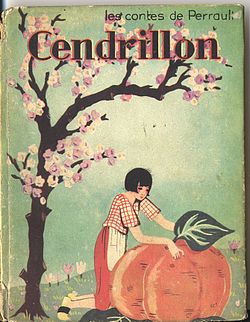 Front cover of a 1930 French picture book edition of Cinderella
Front cover of a 1930 French picture book edition of Cinderella
Cinemas have offered sugary sweet adaptations of the young girl’s journey
from misery to matrimony, such as The Slipper and the Rose
(starring Richard Chamberlain and Gemma Craven, 1976) and Ever After (1998, featuring Drew Barrymore). And, of course, in
the opera house numerous composers have literally given Cinderella a
‘voice’, from Jean-Louis Laruette and Louis Anseaume (1759) to Stefano
Pavesi (1814), from Ermanno Wolf-Ferrari (1900) to Gustav Holst (1901),
from Peter Maxwell Davies (1979) to
Alma Deutscher
(2016), among others.
Of course, the operatic versions of Goodness Triumphant by Giacomo Rossini
(La Cenerentola, 1817) and Massenet (Cendrillon, 1894-6)
are the best-known. But, in the early nineteenth century it was not Rossini
whose Cinderella was most celebrated but that of the Franco-Maltese Nicolas
- or Nicolò, as he called himself - Isouard, whose three-act comic opera, Cendrillon, to a libretto by Charles-Guillaume Etienne
after Charles Perrault, was premiered in the Salle Feydeau at the
Opéra-Comique on 22nd February 1810. And, it is this opéra-féerie by Isouard, who died two hundred years ago, that Bampton Classical Opera -
celebrating their twenty-fifth year - have selected for their 2018
production and which, following performances earlier this summer at Bampton
and Westonbirt, can now be enjoyed at
St John’s Smith Square on 18th September
.
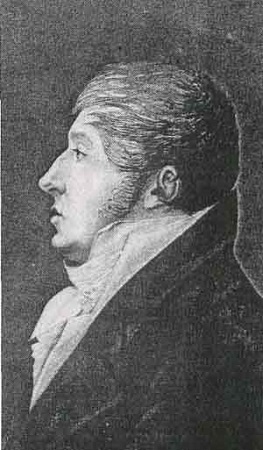 Nicolas Isouard
Nicolas Isouard
So, who was Nicolò Isouard, this composer of more than 40 operas, whose
bust graces the pediments of the Palais Garnier in Paris? The son of a
Marseille merchant, Isouard was born in Valletta on 18th May
1773 (according to Grove; some sources suggest 6th December
1775). His early education, which included mathematics, Latin and music,
took place in Paris at the Pensionnat Berthaud, a preparatory school for
the Engineers and Artillery, but the Revolution forced him to flee back to
Malta in 1789 where his father found him a position in a merchant’s office.
He continued his musical studies - composition with Michel-Ange Vella and
counterpoint with Francesco Azzopardi; when his work took him to Palermo,
he took harmony lessons with Giuseppe Amendola; later, in Naples, he
completed composition studies with Nicola Sala and received practical
advice from Guglielmi.
Isouard made his debut as an opera composer with L'avviso ai maritati in June 1794, which was successfully received
in Florence and later given in Lisbon, Dresden and Madrid. Back home, not
all spoke favourably of Isouard, some questioning his masonic affiliations.
In April 1794, the Maltese Inquisition was told that the composer was ‘a
young man who leads a sinful life, frequenting loose women, and boasting
about it. He ridicules and despises the sacrifice of the Mass [...] those
acquainted with him consider him a libertine’, but despite such
condemnation, in 1795, on the death of Vincenzo Anfossi, Isouard was
appointed organist to the Order of St John of Jerusalem in Valetta, later
becoming maestro di cappella there. He settled in Malta, composing serious
and comic operas for the Maltese theatre.
[1]
The French invasion of the island in June saw him become secretary to the
Governor of the French garrison, Vaubois, and following the French
submission to the British, Isouard, perhaps fearful of charges of
collaboration, returned with the latter to Paris in 1799. His first
Parisian opéra comique, Le petit page, composed
in collaboration with Rodolphe Kreutzer who acted as Isouard’s manager and
patron, was given in the Théâtre Feydeau in February 1800. Friendship with
the librettist F.-B. Hoffman led to the sharpening of his dramatic insight,
and his first major success came with Michel-Ange (1802).
On 5th August 1802, Isouard co-founded - with Luigi Cherubini,
Etienne-Nicolas Méhul, Rodolphe Kreutzer, Adrien Boïeldieu and Pierre Rode
- Le magasin de musique dirigé, a publishing venture which
formally opened in December that year, in premises at 268 rue de la Loi in Paris (in 1805-6 the street number and name were
altered to 76 rue de Richelieu). The company was designed to spare
composers - who in the late-eighteenth century habitually self-published
their works and sold them personally or through music shops - from
financial risk and time-consuming business matters, and to ensure that they
received increased publicity and profit. Each of the six composers was
contracted to furnish at least one opera or 50 pages of music each year,
and each was entitled to the proceeds from the sale of his own works and to
a share in the profits of the firm’s publications of works, mainly
instrumental compositions, by various non-associated contemporary composers
who were popular in Paris at the time.
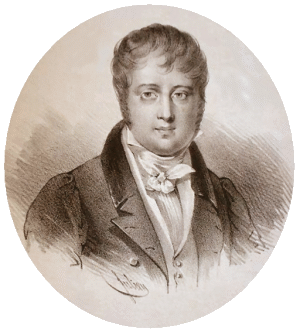 Nicolas Isouard (drawing by Julien, Pierre Durcarme lithography, circa 1830, published by Blaizot, Universal Gallery, Place Vendôme, Paris)
Nicolas Isouard (drawing by Julien, Pierre Durcarme lithography, circa 1830, published by Blaizot, Universal Gallery, Place Vendôme, Paris)
In total more than 650 editions were published, from engraved plates,
including Viotti’s five violin concertos and, notably, the first edition in
full score of Le nozze di Figaro (1807-08). However, of the six
collaborators Isouard - who had the most extensive business experience
among the group - was alone in taking his prescribed obligations seriously:
the firm printed nine of his operas in full score, alongside Cherubini’sAnacréon, Méhul’s Joseph and Boïeldieu’s Ma tante Aurore. He left the firm in July 1807 and on 12 August
1811 the partnership was dissolved, J.-J. Frey acquiring the business,
manuscripts and 9679 engraved plates (of which Isouard’s contribution
accounted for 3,553 engraved pages, about 37% of the total).
[2]
In 1808, with Un jour à Paris, Isouard began his long
collaboration with Etienne, who was the editor of the Journal des deux mondes. Two years later they had an unprecedented
success at the Opéra-Comique in 1810 with the fairy-tale operaCendrillon, and further triumphs followed including Jeannot et Colin (1814) and Joconde (1814), the latter
establishing Isouard’s international reputation. He had little serious
competition among his fellow composers in Paris at this time, but with the
return of Boïedlieu, from Russia, in 1811, a friendly rivalry was
initiated, one which became more acrimonious when both applied for
membership of the Institut de France (1817). Boïeldieu’s success angered
Isouard who broke off relations with his former friend. Indeed, it has been
suggested that Isouard was driven to drink, debauchery and an early death
by his jealousy of Boïeldieu!
[3]
Isouard, Boïeldieu and Méhul are often credited with having brought French opéra comique to its final form. The genre is a significant marker
of changing taste in France in the early years of the nineteenth century.
While the French did share Napoleon’s liking for Italian opera and
aristocratic themes, opéra comique
came to be strongly identified with the cultural appetites of the
post-revolutionary bourgeoisie who, after years of Revolutionary
turmoil and bloodshed, now longed for simple entertainments that would
amuse and bring joy. Characters were drawn from everyday life; plots
involved complicated deceptions and subterfuges; a pair of lovers was
unfailingly at the centre of the drama. The story was advanced by
spoken dialogue and the music was ‘uncomplicated’: melodious strophic
airs and romances, pictorial orchestrations, strongly defined musical
characterisation.
Though the genre is occasionally dismissed as light and trivial, both
Edward J. Dent and Donald Grout argue that it is in the op éra-comique of the years from 1790 to 1815 that we should look for
the origins of mid-nineteenth-century Romantic grand opera.
Isouard certainly achieved great popularity at home and abroad during his
life-time. His operas were performed across Europe; Michel-Ange
was translated into five languages and L’intrigue aux fenêtres
into seven. Born in Hanover in 1795, Sophie Augustine Leo, the writer of
the anonymous Erinnerungen aus Paris (Berlin, 1851), had travelled
to Paris with her elder sister Mme Valentin in 1817, and the year later
married the German banker August Leo, a prominent patron of the arts among
whose regular guests were many distinguished artists living in Paris at
this time. Writing of the ‘masterpieces’ that were being given at the
Opéra-Comique during this period, Sophie remarked Isouard’s achievements:
‘His opera Jeannot et Colin, more especially his Rendezvous bourgeois, sparkled with life and animation; I doubt
whether a more amusing subject than the latter is to be found. Though I can
no longer remember enough of the detail to retell the story, I know that
the merriment of the spectators was endless and that the music had caught
the spirit of the text. L’intrigue aux fenêtres followed, then Cendrillon and Joconde, and Isouard died, aged forty-one,
at the height of his development and in the ever increasing favor of his
public.’
[4]
She also noted that, ‘In 1818, i.e., shortly after my arrival in Paris,
connoisseurs were shocked by the deaths of Isouard and Méhul’.
Frequently composers made adaptations and transcriptions of Isouard opera
airs. In 1810 Jan Ladislav Dussek published his “Variations No.4 in G major
on ‘Toto Carabo’ or ‘Il étoit un petit homme’ from the opera Cendrillon by Nicolò Isouard arranged as a Rondo with Imitations”,
and one of Johann Nepomuk Hummel’s seven sets of variations on opera themes
took Cendrillon as its source.
Isoaurd’s fame and favour reached far afield. In his study of opera in
Philadelphia from 1800-30, Otto Albrecht demonstrates that Isouard’s work
was popular among the 258 different operas presented during in the city
during these thirty-one years. In October 1827 no fewer than three operas
by Isouard were performed: Cendrillon, ou Le petit soulier verd (first performed on 20th
October 1827) was preceded by Joconde, ou Les coureurs d’aventures
(1st October) and Les rendez-vous bourgeois (17 th October), while a year later on 18th October 1828
Isouard’s Lully et Quinault, ou Le déjeuner impossible was staged.
[5]
Further evidence of the dispersal of Isouard’s music in America can be
found in Charlotte le Pelletier’s ambitious Journal of Musick,
published in Baltimore in 1810. Pellier, a pianist and composer, had
arrived in Baltimore from Paris in 1803. A widow with two children, she
worked as a tutor and set about a project to sustain her French cultural
heritage by publishing a collection of songs and piano pieces that would
appeal to other French émigrés for study and performance. The collection
included a large proportion of transcriptions from the latest productions
at the Opéra-Comique, including arrangements for solo keyboard from the
overtures and interludes of Isouard’s Les confidences (1803) and,
drawing upon one of the era’s most popular vocal forms, a transcription of
the ‘romance’ from Isouard’s first great success, Michel-Ange
(1802).
[6]
Isouard and his contemporaries were also all the rage on the Russian stage
in the early 1800s. Among Isouard’s works that reached Moscow were L'intrigue aux fenêtres (1807), Le médecin litre
(1810), and Cendrillon (1811). And, Russian literature did not
neglect him: in Alexander Pushkin’s ‘The Blizzard’ from The Tales of the Late Ivan Petrovich Belkin, one of the principal
characters, describing his experience in the army during the Napoleonic
invasion of Russia, refers to Isouard’s Joconde of 1814:
“Meanwhile, the war had ended in glory. Our regiments were returning from
abroad. People ran to meet them. For music they played conquered songs:
Vive Henri-Quatre, Tyrolean waltzes, and arias from Joconde.” Not
everyone was so enamoured of the man and his music, though. Carl Maria von
Weber thought that Cendrillon’s ‘sweet airs’ possessed ‘nothing to
make an effect on an audience’ and criticised ‘the routine nature of
practically every piece’ in the opera and its ‘clumsy instrumentation’.
[7]
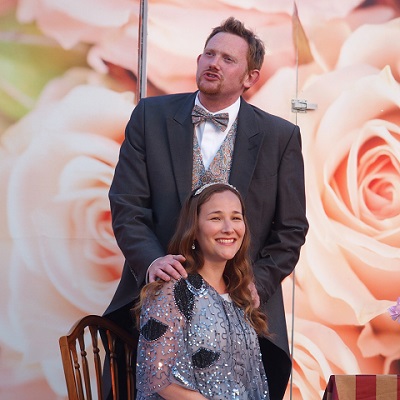 Alidor (Nicholas Merryweather) and Cinderella (Kate Howden), Bampton Classical Opera 2018
Alidor (Nicholas Merryweather) and Cinderella (Kate Howden), Bampton Classical Opera 2018
Some have argued that the artlessness of Cinderella’s musical
characterisation - the unadorned melodic line of the simple romances -
reflects the influence of the rather limited vocal talents of Alexandrine
Saint-Aubin, whose celebrated but brief career was given initial impetus by
this role (sung in Bampton’s production by Kate Howden). But, the decorum
of Cinderella’s strophic songs complements her inner grace, and Isouard
reserves the virtuosity for the two stepsisters, Clorinde and Tisbe (here
Aoife O’Sullivan and Jenny Stafford respectively), who, vain, spoiled and
self-promoting, pull out all the coloratura stops when seeking to attract
the Prince’s attention. Clearly, Isouard had an instinctive sense of how to
match melody and context, and, judging by the concerto elements in the
opera’s overture as well as interesting use of harp and horn throughout, a
good ear for musical colour and pictorialism. There is dramatic interest
and depth, too, in the expanded role for Alidoro, the Prince’s sage and
tutor (played by Nicholas Merryweather in this production).
When Isouard died, at the age of 44, in Paris on 23rd March
1818, his final opera Aladin, ou La lampe merveilleuse was
unfinished. Completed by Benincori, the work was premièred at the Opéra on
6th February 1822, the first opera in Paris to be produced with
gas lighting, and to include an ophicleide in the pit orchestra. But, on 25 th January 1817, an opera had been performed at the Teatro Valle
in Rome which in the coming years would supplant his own Cendrillon: Rossini’s two-act dramma giocoso, La Cenerentola - the libretto of which
acknowledged a debt to Isouard, declaring itself ‘by Jacopo Ferretti after
Charles Perrault’s Cendrillon and librettos by Charles-Guillaume
Etienne for Nicolas Isouard’s Cendrillon (1810, Paris) and
Francesco Fiorini for Stefano Pavesi’s Agatina, o La virtù premiata (1814, Milan)’.
Just as Haydn, Mozart and Beethoven came to dominate instrumental music, so
Rossini, Donizetti and Bellini were predominant in the operatic repertory
by the 1840s. But despite this, other composers continued to achieve
‘popular’ success throughout the nineteenth century, not least as providers
of vocal music to alternate with instrumental works on the concert
programmes of the growing number of subscription societies. Though their
music is infrequently heard today, the most popular - Giovanni Pergolesi,
Giovanni Paisiello, Domenico Cimarosa - remain familiar names. Yet,
composers such as Louis Spohr, Giovanni Viotti, Etienne-Nicolas Méhul,
George Onslow and Robert Franz are now largely excised from music history,
even though in their day their music - alongside that of Nicolas Isouard -
was whistled on the streets.
Although the Opéra-Comique revived Les rendez-vous bourgeois and Joconde after World War I, Isouard’s operas have largely
languished in obscurity for more than one hundred years, though in 1999 the
Australian conductor Richard Bonynge presented Cendrillon in
Moscow, a performance that was recorded live. Last year, Manhattan School
of Music mounted a production, and in June this year, Cendrillon
premiered in Malta itself, in the Manoel Theatre in Valletta (which is the
2018 Cultural Capital of Europe).
Thanks to Bampton Classical Opera, we will have an opportunity to hear in
London music that was recalled so fondly by an anonymous writer in the 15 th May 1854 issue of Revue des deux mondes:
‘I was present a few years ago when Cinderella was rehearsing at
the Opéra-Comique, and I was delighted, I will admit, by the charming
nature of this so naively romantic inspiration. Nicolò produced an effect
on me that Rossini’s music in all its pomp had not been able to produce. I
seemed to hear a real fairy tale in music, and I found in these slightly
shortened phrases, an expression so simple and so touching, [an] air of
childish grace and good-naturedness …’
Claire Seymour
[1]
Expelled from Rhodes by the Turks in 1523, the Sovereign Military
Order of Malta proved itself a notable musical patron, transforming
Maltese cultural life by introducing European customs and taste.
The Order’s musical establishment in its church in Valetta employed
musicians of considerable talent and a number of distinguished
musicians were associated with the Order. See Duane Galles,
‘Chivalric Orders as Musical Patrons’, Sacred Music, Fall
2012, Vol.139, No.3: 25-44.
[2]
Bruce R. Schueneman and María De Jesús Ayala-Schueneman, ‘The
Composers’ House: Le Magasin De Musique De Cherubini, Méhul, R.
Kreutzer, Rode, Nicolo Isouard, Et Boïeldieu’, Fontes Artis Musicae, Vol.51, No 1, 2004: 53-73.
[3]
Geoffrey Álvarez, ‘The singing island’, Musical Times,
Vol.157, Iss.1937, (Winter 2016): 114-117.
[4]
In ‘Musical Life in Paris (1817-1848): A Chapter from the Memoirs
of Sophie Augustine Leo-Part I’, The Musical Quarterly,
Vol.17, No.2 (Apr., 1931): 259-271
[5]
Otto E. Albrecht, ‘Opera in Philadelphia, 1800-1830’, Journal of the American Musicological Society, Vol.32,
No.3 (Autumn, 1979): 499-515.
[6]
Elise K. Kirk, ‘Charlotte Le Pelletier’s Journal of Musick
(1810): A New Look at French Culture in Early America’, American Music, Vol.29, No.2 (Summer 2011): 203-228.
[7]
J. Warrack, ed.: Carl Maria von Weber: Writings on Music
(Cambridge, 1981).
